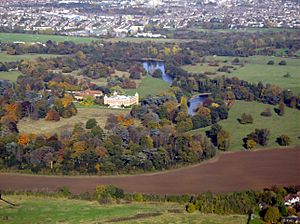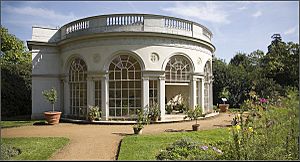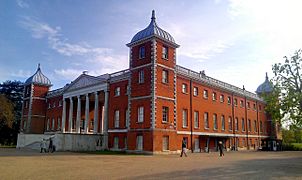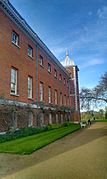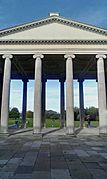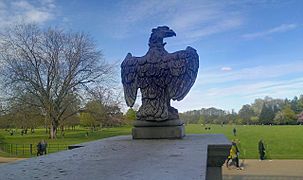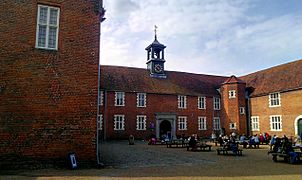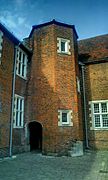Osterley Park facts for kids
Quick facts for kids Osterley House |
|
|---|---|
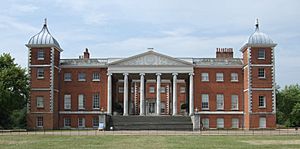 |
|
| Type | Country house |
| Location | Jersey Road, Isleworth, UK |
| Built | 1570s |
| Built for | Sir Thomas Gresham |
| Rebuilt | 1761–1765 |
| Current use | Historic house museum |
| Architect | Robert Adam (1760s) |
| Owner | National Trust |
|
Listed Building – Grade I
|
|
| Official name: Osterley House | |
| Designated | 21 May 1973 |
| Reference no. | 1080308 |
| Lua error in Module:Location_map at line 420: attempt to index field 'wikibase' (a nil value). | |
Osterley Park is a beautiful old country estate in west London. It's located across parts of the London boroughs of Ealing and Hounslow. The estate was first built in the 1570s. Many of its buildings are protected as Grade I or II listed buildings, meaning they are very important historically. The park itself is also a protected Grade II* site. The main house, called Osterley House, was wonderfully redesigned by a famous architect named Robert Adam between 1761 and 1765. Since 1991, the National Trust has looked after Osterley, and both the house and its park are open for everyone to visit.
Contents
History of Osterley Park
The First House at Osterley
The very first building on this land was a large manor house. It was built in the 1570s for a rich banker named Sir Thomas Gresham. He bought the land of Osterley in 1562. This "fair and stately brick house" was finished in 1576. We know that Queen Elizabeth I even visited it! The stable building from that time is still standing at Osterley Park today. Sir Thomas Gresham also started the famous Royal Exchange in London.
The Child Family Takes Over
Later, in the late 1600s, the estate belonged to a developer named Nicholas Barbon. He borrowed money from Child's Bank and sadly died in debt around 1698. Because of this, the estate became owned by the bank's founder, Sir Francis Child, in the early 1710s.
In 1761, Sir Francis's grandsons, Francis and Robert Child, hired a Scottish architect named Robert Adam. Adam was becoming one of the most popular architects in Britain at that time. They wanted him to redesign the house. When Francis Child passed away in 1763, his brother Robert took over the project. Robert Child was the one for whom the amazing new rooms were created.
The house is made of red brick with white stone details. It's shaped like a square, with towers at each of its four corners. Adam's design is very unique, and it looks quite different from the original building. One side of the house is almost completely open. It has a grand screen with columns and a wide set of steps leading to a central courtyard.
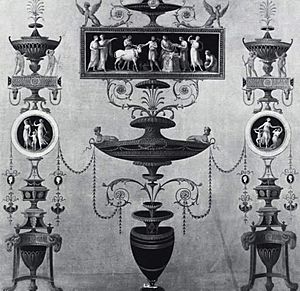
Adam's new interior designs are some of his most famous works. A writer named Horace Walpole once said the drawing room was "worthy of Eve before the fall." The rooms have fancy but simple plasterwork, many different rich colors, and the decorations and furniture match perfectly.
Some special rooms include the entrance hall, which has big curved areas at each end. There's also the Etruscan dressing room. Adam said this room was inspired by "Etruscan" vases. These vases were thought to be from the Etruscan civilization back then, but we now know they were from Ancient Greece. Adam also designed some of the furniture, like the grand domed state bed, which is still in the house.
After Robert Child's Time
Robert Child had only one daughter, Sarah. She married John Fane, 10th Earl of Westmorland, in 1782. When Robert Child died two months later, his will stated that his huge properties, including Osterley, would be held in trust for any second grandchild born to Sarah. This turned out to be Lady Sarah Fane, who was born in 1785.
Robert Child's will was set up to keep his property away from his son-in-law, John Fane. This was because Fane had run away with Child's daughter to get married without Child's permission. Child had wanted his daughter to marry someone who would take on the Child family name.
Lady Sarah Fane, who eventually inherited the estate, married George Villiers in 1804. Since they had children, the estate passed into the Villiers family. In 1819, George Villiers changed his last name to Child Villiers.
Osterley in Later Years
George Child Villiers, 9th Earl of Jersey, decided to open Osterley to the public in 1939. Many people wanted to see its historic rooms. He explained that he didn't live there, and many others wished to see it. About 12,000 people visited the house in its first month! Lord Jersey also held art shows in the top-floor rooms. He wanted to show modern art next to the 18th-century designs downstairs.
Training for the Home Guard
During World War II, the grounds of Osterley Park were used to train the first members of the Local Defence Volunteers. This group later became known as the Home Guard. The 9th Earl of Jersey allowed Captain Tom Wintringham to set up a training school at the park in 1940.
At this school, people learned about modern warfare, how to fight like a guerrilla, and street-fighting techniques. They even used some old estate workers' houses that were going to be torn down for practice. Painter Roland Penrose taught camouflage here. Maj. Wilfred Vernon taught how to make homemade explosives. His old explosives storage building can still be seen behind the house. A Canadian named Bert "Yank" Levy taught knife fighting and hand-to-hand combat. Even though the school became famous around the world, the War Office and Winston Churchill didn't fully approve of it. The War Office took over the school in September 1940, and it closed in 1941. Its staff and courses were moved to other official Home Guard schools.
The National Trust Takes Over
After World War II, Lord Jersey offered the estate to Middlesex County Council, but he eventually decided to give the house and its park to the National Trust. The furniture was sold to the Victoria & Albert Museum. In 1947, Lord Jersey moved to the island of Jersey, taking many paintings from Osterley with him. Sadly, some of these were destroyed in a warehouse fire on the island soon after. Lord Jersey helped the Ministry of Works and the V&A restore the house to how it looked in the late 1700s.
The National Trust officially took charge of Osterley in 1991. The house has received many wonderful items on loan and as gifts from Lord Jersey's family. These include silver, porcelain, furniture, and tiny paintings. In 2014, William Villiers, 10th Earl of Jersey, who is the current Earl, arranged a ten-year loan of portraits of the Child family to Osterley. These pictures include a portrait of Francis Child by Allan Ramsay (painted in 1758) and a portrait of his brother, Robert, by George Romney.
Today, the house and its small formal gardens are open to the public. Many thousands of visitors also enjoy walking the paths and exploring the woodlands of the surrounding park for free. A weekly 5-kilometer Parkrun event also takes place in the park.
The house had its most recent restoration from 2018 to 2021. This work fixed problems with the building's structure and cleaned up the discolored brickwork on the outside.
Gallery
See also
 In Spanish: Osterley Park para niños
In Spanish: Osterley Park para niños


